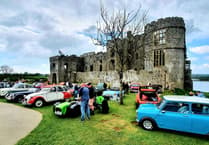Writing of Caldey a hundred years ago, a great scholar, the Rev. Done Bushell, said 'Whilst all that most enriches it is due to the efforts and prayers of those who have passed behind the veil, such memories will still remain a power, none more effectual, to influence and mould our lives'.
He it was who bought Caldey in 1897, embarked on an ambitious programme of restoration of the early Celtic church and the medieval Priory, and was ultimately responsible for bringing monasticism back to the island after a lapse of four-and-a-half centuries following the Reformation.
Whereas, throughout recorded history, the other Pembrokeshire islands have only ever had but the one main household of those and their servants who were farming them, Caldey has differed to the extent that there has always been a number of households there. Early Celtic monks were there for five or six hundred years until the time of the Scandinavian raiders and traders. Following the Norman Conquest, Caldey eventually came into the hands of St. Dogmael's Abbey, whose monks established a Priory on the island in the 1130s, and monasticism then continued there for another four centuries. Many physical reminders of their occupation are still to be seen.
Under Done Bushel's patronage, Benjamin Fearnley Carlyle, later to become known as Dom Aelred, established a Benedictine Community in 1906 and embarked on a financially suicidal building programme. A community of monks of the Cistercian Order, from the Abbey of Notre dame de Scourmont, near Chimay, in Belgium, established the present foundation in 1926.
In addition to the monasticism, at various times throughout the years there has also been commercial activity, farming, market gardening, and the quarrying of limestone. Indeed there was even at one time a sub Priory and, in later years, quarrying for a short time began on neighbouring St. Margaret's Island.
It is part of the Benedictine rule by which they live that the Cistercians have to support themselves by their own efforts. By tradition, therefore, they have mostly been farmers. It is, however, completely impossible to make a living trying to farm an island in the face of the horrendous transport costs and difficulties facing farmers today. The monks, therefore, have developed a successful perfume industry, make chocolate and generally cater for the summer tourist trade.
Throughout it all, especially in the autumn, winter and spring, the monastery, as in Done Bushell's essay, is essentially a place where men feel called to give their lives to God, so that the monastery remains, as ever, the power house of prayer, and contributes so much to the Church and to the world.
Roscoe Howells has written extensively on the history of the Pembrokeshire islands, and his two books, Caldey and Total Community, are acknowledged as the definitive works on the history both of the island and its monastic community.



